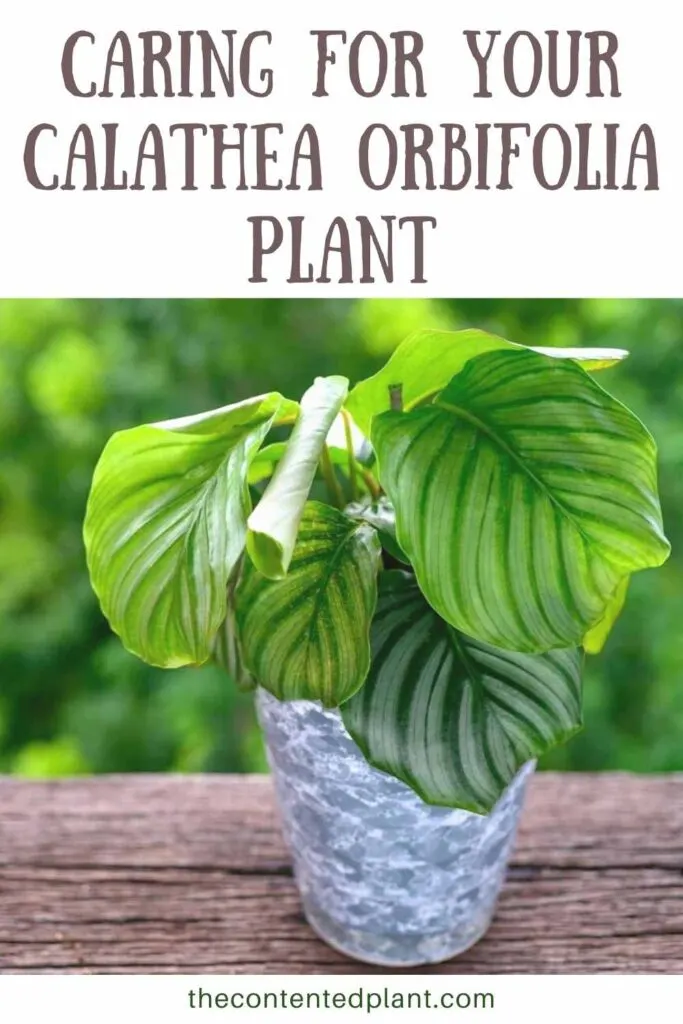Calathea orbifolia plant care is challenging to some and easy for others. If you can easily give this plant what it needs you may consider it an easy plant to grow.
That can often depend on your local climate and the natural light conditions in your home. However, wherever you live you can grow the lovely orbifolia. But you need to give it what it wants to keep it and you a happy plant family.
These gorgeous plants are worth the bit of extra effort. Read our Calathea Orbifolia care tips for detailed information on how to properly care for this incredible plant.
This tropical plant makes a lovely floor bush. It reaches up to three feet tall and wide. Once you learn how to accommodate her orbifolia will reward you with a stunning plant you will enjoys for years and years.
The spectacular and elegant Calathea Orbifolia has large round lush leaves with subtle patterning in grey and silver. The pretty leaves grow in a layered bushy display.
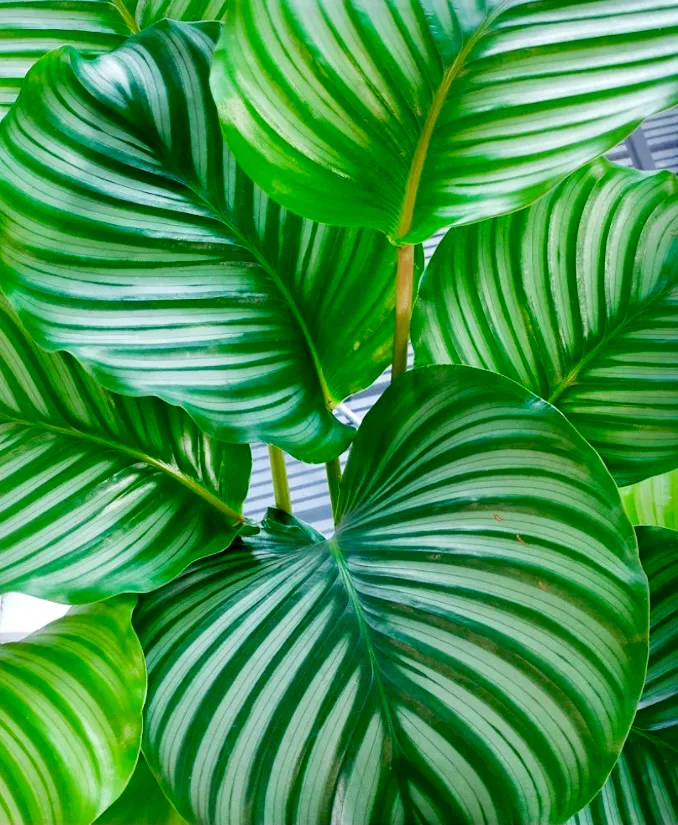
Orbifolia like many other Plants in the Marantaceae plant family has been reclassified to the Goeppertia genus. However, the Geoppertia orbifolia is still commonly known and tagged in most garden shops as a Calathea.
Plants in the Marantaceae family like Calatheas and Goeppertia have reactive leaves that close at night and express leaf movement throughout the day. This is similar to the prayer plants in the genus Maranta.
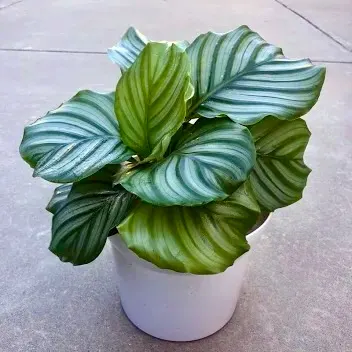
Goeppertia orbifolia grows large striped leaves in a beautiful bushy display.
New leaves grow from tight tube shaped furls. They unwind into lush richly hued leaves that for all their size are rather tender and delicate.
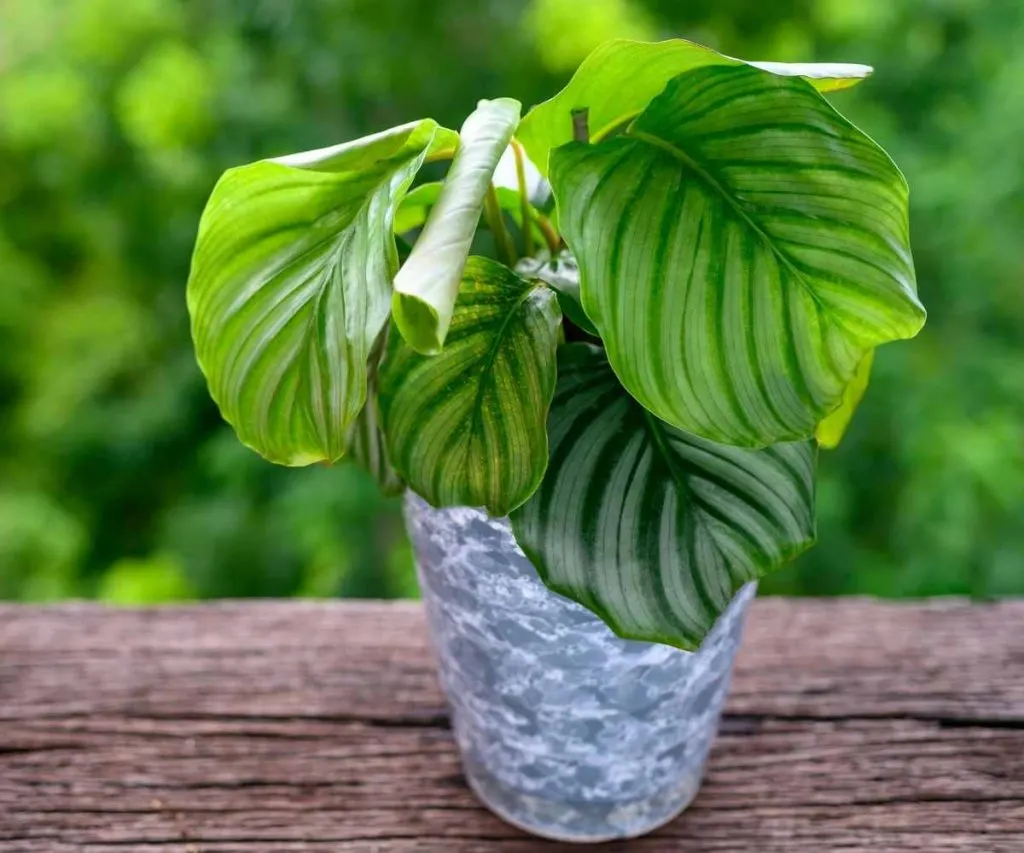
Orbifolia is larger than the Calathia ornata varities and looks wildly different from the popular pinstripe and other Calatheas and Goeppertias. It is rather unique in the collection. But the care needs of this plant are simlar to ornatas and other calatheas.
Calathea Orbifolia Plant Care:
Orbifolias come from the tropical rainforests of Bolivia. The water in the forest is soft and acidic. The air is consistently humid and warm. That is exactly what calathea orbifolia requires we give her.
Plant Placement:
The orbifolia, like all its relatives in the Calatheas genus cannot abide drafty entryways or windows. It doesn’t like intense changes of temperature.
The calathea orbifolia a great addition for our low light houseplant collection. Orbifolias can tolerate lower light and love east facing or bright North facing windows. If you see the leaf colors fade pull the orbifolia back to a lower light.
Repotting:
This fussy girl does not like repotting so be gentle when you do. Orbifolias don’t like being root bound so plan to repot with care. Usually every other year in spring.
The orbifolia grows from rhizomes. If two rhizomes are growing together in a pot you have two plants there. By gently separating the rhizomes you can repot them into separate pots.
Now you have two plants. They may sit several weeks without doing much growing. This is normal. Hopefully the roots will settle in and you will see new growth in a month or so.
Be careful to only separate mature plants that can handle the stress or you may lose one or both of the transplants.
What causes brown leaf tips?
Those gorgeous large lush leaves will show every complaint with browning leaf tips and edges.
Three causes of brown tips on your Calathea Orbifolia:
- Watering with tap water– Sensitive Orbifolia will let you know if your tap water measures up to it’s exacting standards….and if it does not.
- low humidity-The leaf edges will turn crispy and brown if the air is too dry.
- over fertilizing– over fertilizing will cause brown tips due to too many salts taken up by the plant roots
Solutions for Brown leaf Tips and edges:
If you have brown tips and edges READ our best practices care guide below to see how to keep your Orbifolia happy. Here are some important highlights from the guide.
WATERING: The best water for the Orbifolia is rain water or distilled water. Most tap water is full of chemicals and minerals they cannot tolerate. Some touchy Calatheas will even lodge complaints about filtered water.
HUMIDITY:
- Orbifolia enjoys humidity between 50 and 65 %. Your local climate will greatly affect your indoor humidity. If you live in a very dry place count on needing a humidifier.
- A hygrometer is inexpensive here is the two pack I purchased and very helpful in determining if your plant has enough moisture in the air to keep leaf health perfect.
- The humidifier you need again depends on where you live. A whole room humidifier is great for a dedicated plant room. These small humidifiers are what I use in a small areas around my more demanding plants.
- Pebble trays- place trays under your plant with pebbles and keep them half full of water. Orbifolia plants enjoy the humidifying evaporation.
FERTILIZING:
Over fertilizing will cause an accumulation of salts in the plant roots. Consequently, you may see brown spots on the leaves and crisping brown leaf edges.
Run water through the plant for several minutes to leach out the salts. Allow it to drain well. Allow the plant time to recover fully and resume fertilizing. Fertilize at 25% dilution to avoid this problem.
Flowering:
You MIGHT see a flower on your indoor orbifolia. If the plant is very happy and conditions are just right. However, normally indoor calatheas do not flower. So don’t get your hopes up.
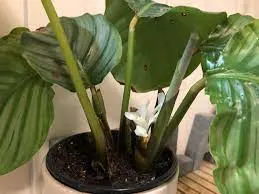
Orbifolias do flower in the wild and occasionally (not often) this can happen indoors.
Read our complete care guide below for even more detailed information on the proper care of your calathea orbifolia. It’s a lovely plant and will grow well with the proper conditions.
If it goes through a bad patch and the leaves get browned or beat up be patient. The orbifolia will grow new beautiful leaves to replace the old one.
You can trim off the brown parts of the leaves if you don’t want to look at them while you are awaiting the beautiful new growth. Just be sure to leave enough leaf to support the plant.
Calathea Orbifolia Care Guide
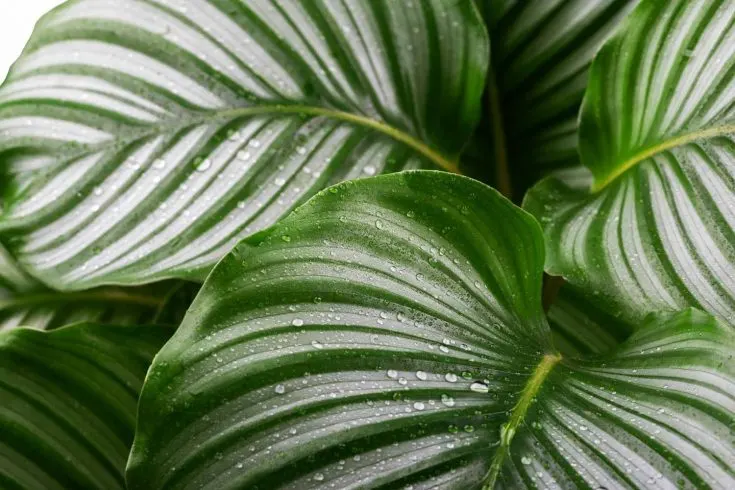
Calathea orbifolia are beautiful, exotic plants with wide appeal. Their care needs are specific and important.
Once you find the perfect growing conditions for your calathea it will perform well for you.
Learn what they need and give it to them. Their lovely foliage (in some cases they even flower) are so worth the effort!
All Calathea plant care is similar. No matter what type you own this care guide will apply.
Materials
Instructions
Soil Preference:
- Calatheas enjoy a light well draining soil.
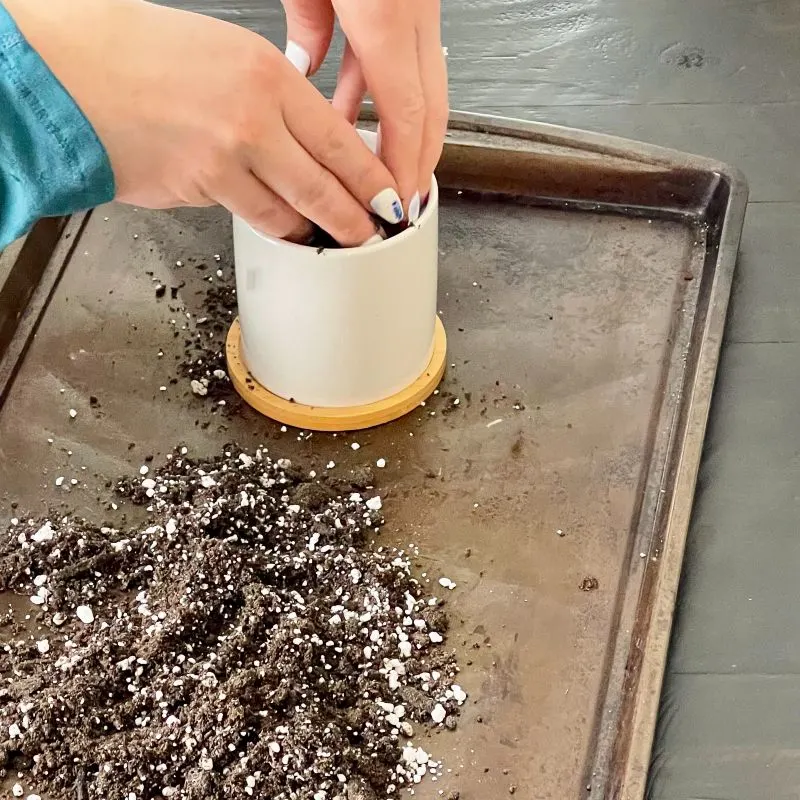
- A mix of potting soil and perlite will keep the roots happiest.
- Our mix for this plant is 70 % potting mix to 30% perlite.
- A heavy soil potting mix is not recommended for these plants.
Pot Size and Type: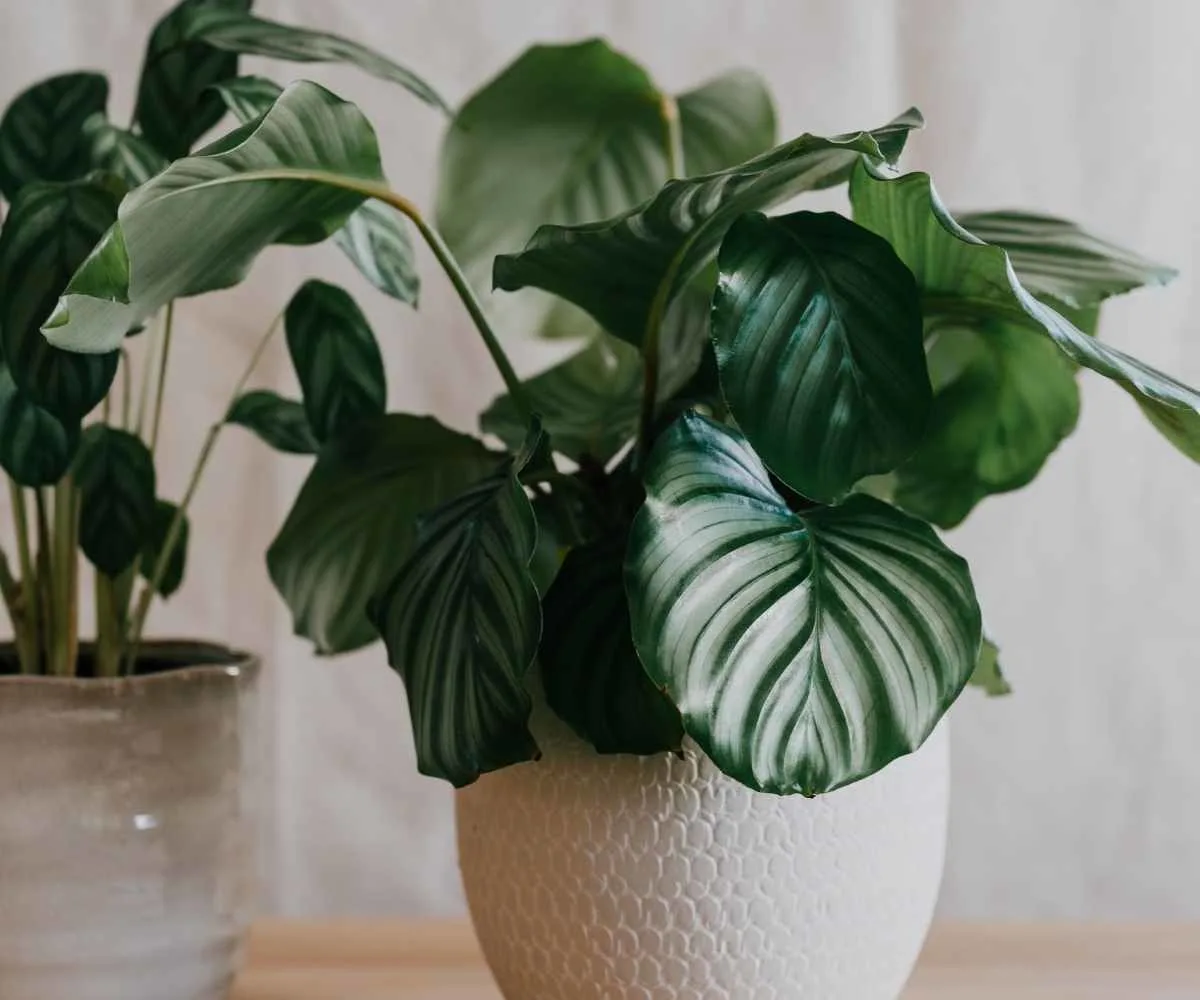
- Calatheas grow from rhizomes. And they grow new offshoots to the sides of the mother plant.
- This means they will fill a pot out as a wider plant eventually. Orbifolia is a good floor plant in proper conditions. It will grow up to three feet tall and wide so plan to give it room as it grows.
- If you leave it to grow as a grouping in one pot you will need to find a pot that is =not overly deep and has a wider circumference. They do not like to be overly root bound.
- If you want to encourage faster growth choose a pot about 2 inches wider in diameter than the current pot.
- Any well drained pot can be used. It MUST have excellent drainage.
- Terra cotta pots are not recommended. They will wick too much water away from the soil.
- Repot every second year or when roots come out the drainage holes on the pot bottom To the next pot size up.
- Don't jump to a huge pot from a small one unless you wish to encourage faster growth. Just go to the next size up pot.
- For Calatheas self watering pot systems work well. (linked above). They control the watering for you and help avoid root rot, overwatering and under watering.
- Calatheas enjoy evenly moist soil so self watering systems help here.
Lighting:
- Calatheas all enjoy indirect light for best leaf variegation and optimal growth.
- If the leaves of orbifolia fade move it to a less bright area and see if that helps. Too much light can fade the leaves and crisp the leaf edge.
- It will tolerate lower indirect light but the plant may grow more slowly. Leaf variegations may not be well expressed.
- Shield this plant from strong direct light. The leaves will burn and the colors will fade. Look for dry brown spots on the leaves and curling brown edges. If you see them move the plant to lower light.
Watering:
- Calatheas are sensitive to the water you use. These are plants accustomed to soft acid water from rain forests. Hard water high in minerals and salts will cause trouble for them.
- Let your tap water sit for 24 hours to allow any chemicals to dissipate. Filtered water, rain water and distilled water are recommended.
- Water your Calathea orbifolia when the soil is dry down an inch or so. Calatheas enjoy even moisture in the soil. But never let it sit in soaking wet potting mix.
- If your calathea orbifolia leaves start to roll up and curl or the plant droops it's probably too dry.
- If the edges of the leaves turn brown suspect under watering, low humidity or water high in chemicals, mineral and salts..
- Over watering will end in root rot, grey mold on the leaves, algae growth on the soil and fungus gnats or other pests moving in.
- Try a watering schedule of once a week. But do not water if the soil is wet. Alternately, Do not let the soil dry out completely.
- Watering is best done on a regular schedule. Keep the soil evenly moist. Water when the top of the soil is dry down an inch or more. Drench the plant to where the water drips out the bottom of the pot.
- These tropical plant enjoy humidity of 40 to 60%. Too dry air results in crispy leave edges.
- In dry climates this plant will thrive with a humidifier nearby. Or set it in your kitchen or bathroom.
- More humidity tricks: Set the plant on a pebble tray with water not touching the soil for added humidity as necessary. Grouping plants together will provide more humid conditions.
- In dormant winter months reduce watering to when the soil is dry down 2 inches .
- Never let this plant get wet feet. If the soil is compacted the bottom of the soil can remain wet which encourages, grey mold on the leaves, root rot and Fungus Gnats. If you see yellow leaves or brown curling leaf edges you are probably overwatering or Inconsistently watering.
- self watering planters are a good choice for calatheas. They remove many of the watering problems listed here.
How to Fertilize:
- Calathea Orbifolia requires a regular fertilizing schedule.
- Apply a good quality fertilizer (linked in materials) monthly through Spring and summer.
- Decrease feedings by late Fall and allow your Calathea plant to rest through the winter months.
- Look for brown spots on the leaves of your plants. This may indicate an over concentration of salts in the roots from over feeding. It can burn the leaves.
- The remedy is to set the plant under a faucet of water and let the water run through for 10 minutes or so. Allow the pot to Completely drain. Discontinue fertilizer until the plant recovers.
Temperature:
- Optimal temperatures for Calatheas are 65 degrees F. to 75 degrees F.
- Calatheas are sensitive to cold drafts from windows and doors.
- In winter, beware heat vents blowing on your plant leaves. Calatheas cannot tolerate uneven heating, or drying heat vents or drafts.
Pruning and Training:
- Sharp Hand pruners are preferred for pruning. They will give a clean cut that will heal quickly.
- Cut off the leaves of Calatheas at the soil line.
- Pruning is usually done to shape the plant or keep it small.
- Calatheas grow wider rather than taller. This makes them ideal table top or window sill plants.
Leaf Care:
- For the best care leaves enjoy occasional washing.
- This helps keep the stomata (leaf pores) open for plant respiration.
- Healthy leaves with a good clean surface are most able to resist pests.
- Dusty leaves will starve the plants of water exchange through humidity.
- Hand Wash the leaves monthly with water.
- You can also use a shower to clean off a calathea. Beware the water temperature. Keep it room temperature to avoid shocking the plant.
Pests:
- All plants get attacked by pests. Calatheas are especially susceptible to spider mites.
- Stress by longterm poor watering practices, poor light, extreme temperatures and soil conditions are contributors to pests. Fungus gnats will set up house in the soggy soil of an overwatered plant.
- Washing the plant leaves occasionally will help keep pests from establishing themselves on the plant.
- Spider mites are the biggest problem for Calathea plants. Watch for the webs. Treat immediately and continue for two weeks or more to remove the next generation of spider mites after the adults die. Eggs attach to the leaves and cannot be washed off easily.
- Mealy bugs, scale, thrips and whitefly are also common houseplant pests you will see in a stressed Calathea.
- Read our post on How to get rid of aphids and other pests with our homemade pesticide soap recipe or neems oil.
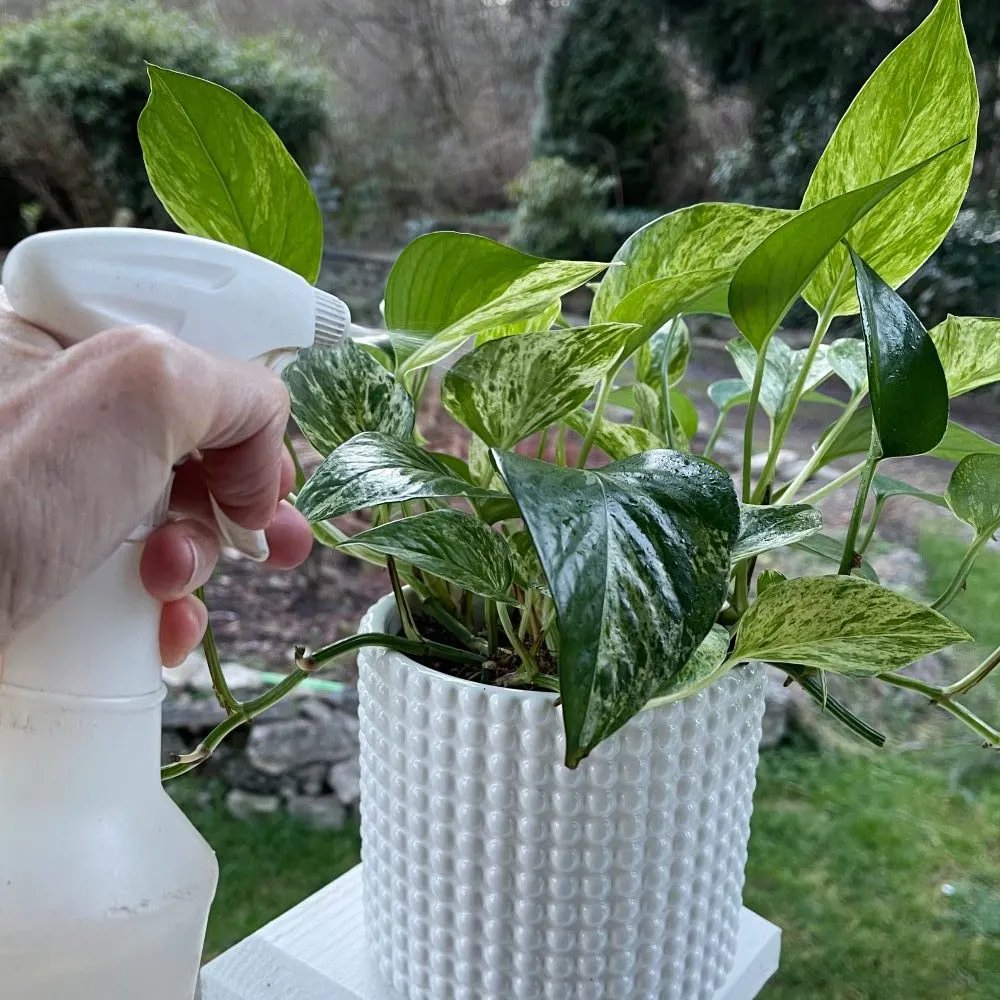
- To minimize the possibility of pests be sure to check all nursery plants before bringing them home. Carefully examine the top and bottom of the leaves.
- Do NOT purchase plants with signs of pest damage or disease.
- Quarantine all new plants until you are sure no pests live in them.
How to Propagate Calathea Orbifolia:
- Propagation is best done through root division.
- Seed propagation can be done but the seeds can be difficult to source.
- Dividing a calathea is easiest when repotting it in spring or summer.
- Unpot the plant gently. Look at the root system. If the plant is mature you should see a natural parting in the leaves and roots. This is the two plants growing together.
- Gently pull the two parts to separate them. If the roots are heavily intertwined cut them as necessary with sharp sterile scissors or small pruners.
- Pot the two plant sections in separate pots. In 2 to 4 weeks the divisions should be settled and growing.
Non Toxic Plant: - All calatheas are non toxic to humans and pets. Still it not recommended to chew any houseplant.
- Biting or swatting are not good for the health of the plant.
- Also you don't know what chemicals or pathogens are in the soil or fertilizers you use. So best practice is to keep houseplants away from pets and kids.
Follow Us:
Find us on YouTube, Instagram , Pinterest and TikTok! We love to Plant chat. We also comment, like and occasionally share your content to our daily stories. We’d love to see your plants. Share your joy in your houseplants. Happy Planting!
